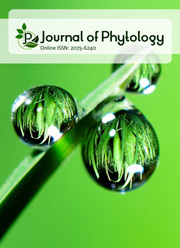Green synthesis of silver nanoparticles using Eugenia uniflora extract, its characterization, antioxidant, and anti‑inflammatory activities
DOI:
https://doi.org/10.25081/jp.2025.v17.9701Keywords:
Eugenia uniflora, Green synthesis, Silver nanoparticles, Antioxidant, Anti-inflammatoryAbstract
Nowadays, the use of environmentally benign raw materials, especially medicinal plants, is preferred in the preparation of nano substances known as nanoparticles (NPs), for use in various biological applications. Eugenia uniflora is an edible plant with enormous medicinal uses owing to its rich phytochemical content. Therefore, this study was carried out to obtain an E. uniflora extract-based silver nanoparticles (Eu-Ag NPs), and to elucidate its antioxidant and anti-inflammatory potential. The NPs were prepared by a conventional green synthesis method. The ultraviolet visible (UV-Vis) and energy-dispersive X-ray (EDX) spectroscopy, X-ray diffraction (XRD) method, and field emission scanning electron microscopy (FESEM), assisted with characterization of the NPs. In vitro antioxidant analysis was based on hydrogen peroxide (H2O2), nitric oxide (NO), superoxide, and hydroxyl radical scavenging assay methods. The inhibitory effect of the NPs on egg albumin denaturation (EAD) was used for the in vitro anti-inflammatory screening. Morphological assessment of the Eu-Ag NPs by FESEM revealed the shape to be spherical to cubical. The maximum absorption peak at 410 nm suggests the formation of AgNPs, while the conversion of metallic silver into elemental silver was confirmed by EDX with 99.50%. The FESEM showed a median size of 45.35 nm for the NPs. The Eu-Ag NPs had good antioxidant and anti-inflammatory potentials, exhibiting an IC50 of 48.91±0.12 and 157.41±0.90 μg/mL against H2O2 radical and EAD, respectively. This study has shown that E. uniflora leaf aqueous extract-mediated silver nanoparticles possess unique structural attributes with considerable antioxidant and anti-inflammatory properties.
Downloads
References
Almatroudi, A. (2020). Silver nanoparticles: Synthesis, characterisation and biomedical applications. Open Life Sciences, 15(1), 819-839. https://doi.org/10.1515/biol-2020-0094
Amorim, A. C. L., Lima, C. K. F., Hovell, A. M. C., Miranda, A. L. P., & Rezende, C. M. (2009). Antinociceptive and hypothermic evaluation of the leaf essential oil and isolated terpenoids from Eugenia uniflora L. (Brazilian Pitanga). Phytomedicine, 16(10), 923-928. https://doi.org/10.1016/j.phymed.2009.03.017
Banerjee, S., Islam, S., Chattopadhyay, A., Sen, A., & Kar, P. (2022). Synthesis of silver nanoparticles using underutilized fruit Baccaurea ramiflora (Latka) juice and its biological and cytotoxic efficacy against MCF-7 and MDA-MB 231 cancer cell lines. South African Journal of Botany, 145, 228-235. https://doi.org/10.1016/j.sajb.2021.09.016
Bhakya, S., Muthukrishnan, S., Sukumaran, M., & Muthukumar, M. (2016). Biogenic synthesis of silver nanoparticles and their antioxidant and antibacterial activity. Applied Nanoscience, 6, 755-766. https://doi.org/10.1007/s13204-015-0473-z
Biswas, R., Alam, M., Sarkar, A., Haque, M. I., Hasan, M. M., & Hoque, M. (2022). Application of nanotechnology in food: Processing, preservation, packaging and safety assessment. Heliyon, 8(11), e11795. https://doi.org/10.1016/j.heliyon.2022.e11795
Burkill, H. M. (1997). The useful plants of west tropical Africa (Vol. 4). Kew, UK: Royal Botanic Gardens.
Consolini, A. E., & Sarubbio, M. G. (2002). Pharmacological effects of Eugenia uniflora (Myrtaceae) aqueous crude extract on rat's heart. Journal of Ethnopharmacology, 81(1), 57-63. https://doi.org/10.1016/s0378-8741(02)00039-9
Das, D., Ghosh, R., & Mandal, P. (2019). Biogenic synthesis of silver nanoparticles using S1 genotype of Morus alba leaf extract: Characterization, antimicrobial and antioxidant potential assessment. SN Applied Sciences, 1, 1-16. https://doi.org/10.1007/s42452-019-0527-z
Das, P., Ghosal, K., Jana, N. K., Mukherjee, A., & Basak, P. (2019). Green synthesis and characterization of silver nanoparticles using belladonna mother tincture and its efficacy as a potential antibacterial and anti-inflammatory agent. Materials Chemistry and Physics, 228, 310-317. https://doi.org/10.1016/j.matchemphys.2019.02.064
Duman, H., Eker, F., Akdaşçi, E., Witkowska, A. M., Bechelany, M., & Karav, S. (2024). Silver nanoparticles: A comprehensive review of synthesis methods and chemical and physical properties. Nanomaterials, 14(18), 1527. https://doi.org/10.3390/nano14181527
Fontana, M., Mosca, L., & Rosei, M. A. (2001). Interaction of enkephalins with oxyradicals. Biochemical Pharmacology, 61(10), 1253-1257. https://doi.org/10.1016/s0006-2952(01)00565-2
Iravani, S., Korbekandi, H., Mirmohammadi, S. V., & Zolfaghari, B. (2014). Synthesis of silver nanoparticles: Chemical, physical and biological methods. Research in Pharmaceutical Sciences, 9(6), 385-406.
Jafarzadeh, S., Oladzadabbasabadi, N., Dheyab, M. A., Lalabadi, M. A., Sheibani, S., Ghasemlou, M., Esmaeili, Y., Barrow, C. J., Naebe, M., & Timms, W. (2025). Emerging trends in smart and sustainable nano-biosensing: The role of green nanomaterials. Industrial Crops and Products, 223, 120108. https://doi.org/10.1016/j.indcrop.2024.120108
Kar, P., Banerjee, S., Saleh-E-In, M. M., Anandraj, A., Kormuth, E., Pillay, S., Al-Ghamdi, A. A., Ali, M. A., Lee, J., Sen, A., Naidoo, D., Roy, A., & Choi, Y. E. (2022). β-Sitosterol conjugated silver nanoparticle-mediated amelioration of CCl4-induced liver injury in Swiss albino mice. Journal of King Saud University - Science, 34, 102113. https://doi.org/10.1016/j.jksus.2022.102113
Kar, P., Oriola, A. O., Singh, M., & Oyedeji, A. O. (2025). Myricitrin-mediated biogenic silver nanoparticle synthesis, characterization, and its antioxidant, anticancer, and DNA cleavage activities. Pharmacognosy Journal, 17(2), 121-128. https://doi.org/10.5530/pj.2025.17.17
Khan, I., Saeed, K., & Khan, I. (2019). Nanoparticles: Properties, applications and toxicities. Arabian Journal of Chemistry, 12(7), 908-931. https://doi.org/10.1016/j.arabjc.2017.05.011
Kumar, R. S., Rajkapoor, B., & Perumal, P. (2012). Antioxidant activities of Indigofera cassioides Rottl. Ex. DC. using various in vitro assay models. Asian Pacific Journal of Tropical Biomedicine, 2(4), 256-261. https://doi.org/10.1016/S2221-1691(12)60019-7
Kunchandy, E., & Rao, M. N. A. (1990). Oxygen radical scavenging activity of curcumin. International Journal of Pharmaceutics, 58(3), 237-240. https://doi.org/10.1016/0378-5173(90)90201-E
Long, L. H., Evans, P. J., & Halliwell, B. (1999). Hydrogen peroxide in human urine: Implications for antioxidant defense and redox regulation. Biochemical and Biophysical Research Communications, 262(3), 605-609. https://doi.org/10.1006/bbrc.1999.1263
Mandal, K., Das, D., Bose, S. K., Chaudhuri, A., Chakraborty, A., Mandal, S., Ghosh, S., & Roy, S. (2024). Spectroscopic approach to optimize the biogenic silver nanoparticles for photocatalytic removal of ternary dye mixture and ecotoxicological impact of treated wastewater. Scientific Reports, 14, 31174. https://doi.org/10.1038/s41598-024-82341-7
Martemucci, G., Costagliola, C., Mariano, M., D’Andrea, L., Napolitano, P., & D’Alessandro, A. G. (2022). Free radical properties, source and targets, antioxidant consumption and health. Oxygen, 2(2), 48-78. https://doi.org/10.3390/oxygen2020006
Matsumura, T., Kasai, M., Hayashi, T., Arisawa, M., Momose, Y., Arai, I., Amagaya, S., & Komatsu, Y. (2000). α-Glucosidase inhibitors from Paraguayan natural medicine, Nangapiry, the leaves of Eugenia uniflora. Pharmaceutical Biology, 38(4), 302-307. https://doi.org/10.1076/1388-0209(200009)3841-AFT302
Ogunwande, I. A., Olawore, N. O., Ekundayo, O., Walker, T. M., Schmidt, J. M., & Setzer, W. N. (2005). Studies on the essential oils composition, antibacterial and cytotoxicity of Eugenia uniflora L. International Journal of Aromatherapy, 15(3), 147-152. https://doi.org/10.1016/j.ijat.2005.07.004
Oriola, A. O., Miya, G. M., Singh, M., & Oyedeji, A. O. (2023). Flavonol glycosides from Eugenia uniflora leaves and their in vitro cytotoxicity, antioxidant and anti-inflammatory activities. Scientia Pharmaceutica, 91(3), 42. https://doi.org/10.3390/scipharm91030042
Patil, M. P., & Kim, G. D. (2017). Eco-friendly approach for nanoparticles synthesis and mechanism behind antibacterial activity of silver and anticancer activity of gold nanoparticles. Applied Microbiology and Biotechnology, 101, 79-92. https://doi.org/10.1007/s00253-016-8012-8
Said, Z., Pandey, A. K., Tiwari, A. K., Kalidasan, B., Jamil, F., Thakur, A. K., Tyagi, V. V., Sarı, A., & Ali, H. M. (2024). Nano-enhanced phase change materials: Fundamentals and applications. Progress in Energy and Combustion Science, 104, 101162. https://doi.org/10.1016/j.pecs.2024.101162
Santhosh, P. B., Genova, J., & Chamati, H. (2022). Green synthesis of gold nanoparticles: An eco-friendly approach. Chemistry, 4(2), 345-369. https://doi.org/10.3390/chemistry4020026
Singh, H., Desimone, M. F., Pandya, S., Jasani, S., George, N., Adnan, M., Aldarhami, A., Bazaid, A. S., & Alderham, S. A. (2023). Revisiting the green synthesis of nanoparticles: Uncovering influences of plant extracts as reducing agents for enhanced synthesis efficiency and its biomedical applications. International Journal of Nanomedicine, 18, 4727-4750. https://doi.org/10.2147/IJN.S419369
Unuofin, J. O., Otunola, G. A., & Afolayan, A. J. (2017). Phytochemical screening and in vitro evaluation of antioxidant and antimicrobial activities of Kedrostis africana (L.) Cogn. Asian Pacific Journal of Tropical Biomedicine, 7, 901-908.
Published
How to Cite
Issue
Section
Copyright (c) 2025 Ayodeji O. Oriola, Pallab Kar, Adebola O. Oyedeji

This work is licensed under a Creative Commons Attribution 4.0 International License.





 .
.